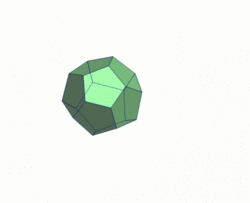Blooming (geometry)

In the geometry of convex polyhedra, blooming or continuous blooming is a continuous three-dimensional motion of the surface of the polyhedron, cut to form a polyhedral net, from the polyhedron into a flat and non-self-overlapping placement of the net in a plane. As in rigid origami, the polygons of the net must remain individually flat throughout the motion, and are not allowed to intersect or cross through each other. A blooming, reversed to go from the flat net to a polyhedron, can be thought of intuitively as a way to fold the polyhedron from a paper net without bending the paper except at its designated creases.
An early work on blooming by Biedl, Lubiw, and Sun from 1999 showed that some nets for non-convex but topologically spherical polyhedra have no blooming.[1]
The question of whether every convex polyhedron admits a net with a blooming was posed by Robert Connelly, and came to be known as Connelly’s blooming conjecture.[2] More specifically, Miller and Pak suggested in 2003 that the source unfolding, a net that cuts the polyhedral surface at points with more than one shortest geodesic to a designated source point (including cuts across faces of the polyhedron), always has a blooming. This was proven in 2009 by Demaine et al., who showed in addition that every convex polyhedral net whose polygons are connected in a single path has a blooming, and that every net can be refined to a path-connected net.[3] It is unknown whether every net of a convex polyhedron has a blooming, and Miller and Pak were unwilling to make a conjecture in either direction on this question.[2]
| Unsolved problem in mathematics: Does every net of a convex polyhedron have a blooming? (more unsolved problems in mathematics)
|
Because it is unknown whether every convex polyhedron has a net that cuts only edges of the polyhedron, and not across its faces ("Dürer's conjecture"), it is also unknown whether every convex polyhedron has a blooming that cuts only edges. In an unpublished manuscript from 2009, Igor Pak and Rom Pinchasi have claimed that this is indeed possible for every Archimedean solid.[4]
The problem of finding a blooming for a polyhedral net has also been approached computationally, as a problem in motion planning.[5][6][7]
References
- ↑ "When can a net fold to a polyhedron?", Computational Geometry 31 (3): 207–218, 2005, doi:10.1016/j.comgeo.2004.12.004. Announced at the Canadian Conference on Computational Geometry, 1999.
- ↑ 2.0 2.1 Miller, Ezra (2008), "Metric combinatorics of convex polyhedra: Cut loci and nonoverlapping unfoldings", Discrete & Computational Geometry 39 (1–3): 339–388, doi:10.1007/s00454-008-9052-3. Announced in 2003.
- ↑ "Continuous blooming of convex polyhedra", Graphs and Combinatorics 27 (3): 363–376, 2011, doi:10.1007/s00373-011-1024-3. Announced at the Japan Conference on Computational Geometry and Graphs, 2009.
- ↑ Pak, Igor; Pinchasi, Rom (2009), How to cut out a convex polyhedron, https://www2.math.technion.ac.il/~room/ps_files/PP_bloom.pdf, retrieved 2021-06-21. As cited by (Demaine Demaine).
- ↑ Song, Guang (February 2004), "A motion-planning approach to folding: From paper craft to protein folding", IEEE Transactions on Robotics and Automation 20 (1): 60–71, doi:10.1109/tra.2003.820926
- ↑ Xi, Zhonghua; Lien, Jyh-Ming (September 2015), "Continuous unfolding of polyhedra – a motion planning approach", 2015 IEEE/RSJ International Conference on Intelligent Robots and Systems (IROS), IEEE, doi:10.1109/iros.2015.7353828
- ↑ Hao, Yue; Kim, Yun-hyeong; Lien, Jyh-Ming (June 2018), "Synthesis of fast and collision-free folding of polyhedral nets", Proceedings of the 2nd ACM Symposium on Computational Fabrication, ACM, doi:10.1145/3213512.3213517
 |

